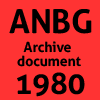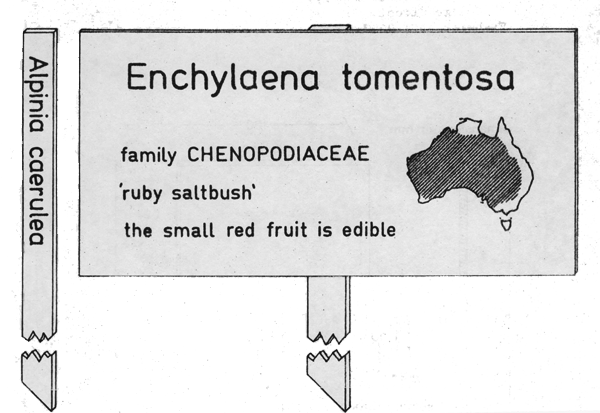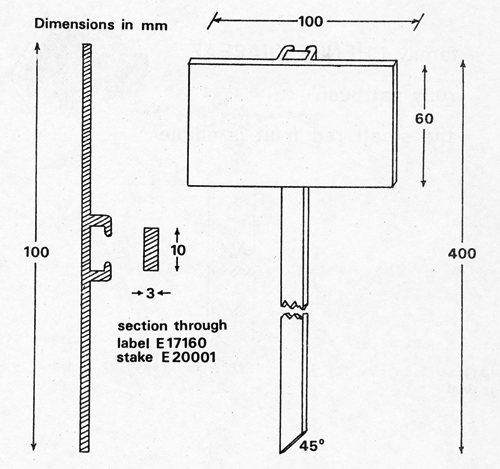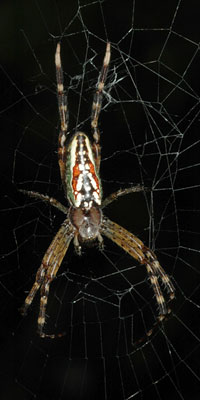 ANBG Archive Document, 1980
ANBG Archive Document, 1980
Published in: The Development of a Botanic Gardens. Proceedins of a conference held at Coffs Harbour Technical College, May 5-9, 1980. University of New England, Armidale, 1980.
Botanic Gardens Labels - a practical guide
by Murray Fagg, Education officer,
National Botanic Gardens, Canberra
Plant labels play a vital role in the establishment of a botanic garden and considerable thought should be given to initiating a system which can keep up with the rate of planting, at a cost that is within the a scope of the institution.
Labels are costly, and several labelling systems are often required:
- Cheaper labels, with minimal information, which can be afforded for every garden planting:
- The 'ideal label which would be good to have on every plant if finances permitted (in practice these might be restricted to prominent or spectacular specimens)
- the expensive interpretive label for special plants.
In this very brief resume I have only attempted to outline costs for permanent labels to be read by visitors and have omitted plastic stick-on 'Dymo-tape' and the soft aluminium-foil tags and similar short-term materials.
Leaving aside detailed interpretive labels, I would suggest that the ideal label should have:
- The Genus and the species of the plant, using upper and lower case lettering. This should be the largest lettering and should be at the top of the label as befits its importance.
- The Family to which it belongs in smaller distinctive perhaps upper case) lettering, ideally prefixed by the word family', as this level of classification is less familiar to the average visitor
- The vernacular name, if there really is one in common usage
- A distribution map or less satisfactorily, a worded distribution.
- Possibly a few words of additional information about the plant.
I assume that on this label or attached to the plant, perhaps concealed, is a registration number.
The minimum information required for each plant would be the generic and specific name, plus the registration number which links it to some recording system.
The range of materials that have been used for labels is too broad to cover here, and I will confine myself to those with which I am familiar. It is not practical to attempt to outline labour costs, but as an estimate, a label fitting the above ideal standards, omitting (e), would take about 20 minutes to complete using an engraving process.
It must be remembered that a label-plate must still be supported, either directly onto a tree, or by a stake or holder fixing it to the ground in front of the plant. some types of label-plate holders could become more expensive than the label-plate.
The obvious answer for detailed interpretive labels is photo-metal, requiring some form of artwork and layout using transfer lettering (i.e. Lettraset) or photographically enlarged electric typewriting to be prepared prior to sending the material to the manufacturer. The resultant sheet of photo-metal must then be mounted, more firmly than usual as its attractive nature is often appealing to light-fingered visitors.
Approximate costs and suppliers for some label material and equipment
A. Engraved labels
- An engraving machine suitable for cutting through the surface layer of plastic or aluminium and following the outline of lettering templates
'Gravograph IM3' machine Cost: $750
set of upper/lower case letter-templates,
(a) maximum engraved size 8mm (B 0051 3020) $90
(b) maximum engraved size 20mm (C 00513050) $220
Supplier: Leo Rogaly & Lewis Pty. Ltd.,
94/96 Cooper street,
Surry Hills,
NSW 2010.
- Labels are usually made of a plastic material which has a surface layer of a different coloured material to that beneath, or aluminium which has been anodized with a coloured surface layer. The engraving machine cuts through this top layer producing the letters.
The costs outlined in the Table below are unit costs when quantities of about 2000 are ordered. The size of 300mm x 150mm is based on those used at the National Botanic Gardens, but provides a suitable guide for comparing costs if other sizes are used.
A stake label would provide space for a generic and species name only, while the National Botanic Gardens rockery label described later would have additional space for the family name.
| MATERIAL | TYPE | SIZE (supplied cut to size) | COST (before engraving) |
| ™ Formica | Plate needing support | 300mm x 150mm | $1.14 each |
| ™ Gravinyl | Plate needing support | 300mm x 150mm | $1.80 each |
| ™ Melomine | Plate needing support | 300mm x 150mm | $1.40 each |
| Aluminium | Plate needing support | 300mm x 150mm anodized one side anodized both sides |
$1.00 each $1.14 each |
| Aluminium | Stake, self-supporting | 440mm x 24mm x 3mm fully anodized, 45° one end |
$0.54 each |
| Aluminium | Label & stake (see diagram below) self-supporting |
100mm 60mm; 40mm stake fully anodized |
$0.72 each |
| SUPPLIERS | ||
| ™ Formica | ™ Gravinyl, ™ Melomine | Aluminium |
| Nover & Co 52 Barrier Street Fyshwick, ACT, 2609 |
Leo Rogaly & Lewis Pty Ltd 94/96 Cooper Street Surry Hills, NSW, 2010 |
Comalco Aluminium Supply 47 Collie Street Fyshwick, ACT, 2609 |
B. Photo-metal labels
Photo-metal labels are produced by transforming a photographic image into the anodized surface layer of a sheet of aluminium. The surface layer can be glossy or matt, and many different thicknesses of aluminium and sheet sizes are available.
If finished same-size art work, lettering, drawing, with or without half-tone photos) is supplied to the manufacturer, approximate costs for some smaller sizes of unmounted labels are:
line artwork (no half-tone) 300mm x 150 mm cost: $13.20 ea
line artwork half-tone) 300 mm x 150mm cost: $24.20 ea
line artwork (no half-tone) 300mm x 250mm cost: $17.60 eaSupplier: Altone Pty. Ltd. 1-3 Mercury Street, Beverly Hills, NSW, 2209
 A stake label (left) of anodized aluminium with minimum information. A suggested layout for the 'ideal' label (above) wich could be engraved |
Comalco label designed for National Botanic Gardens Rockery
The label set out below was designed by the Canberra branch of Comalco and the National Botanic Gardens for use in the newly developed Rockery where it was considered that the usual stake-label would look out of place The total cost is 72c each (with orders of approximately 2000) which includes the stake and requires no additional fixative for mount ing. The label can be stored and engraved separately from its stake.
The stake can be bent on site to an acceptable angle for viewing, and can be readily cut down to a shorter length with heavy duty tin-snips if this is required.
A light bend with the aid of pliers at the time of placement of the label ensures a tight fit with the stake, or this can be made permanent by a sharp blow to the back of the label. The finish is matt olive-grey revealing silver lettering when the anodized layer is engraved.
The manufacturing rights of this label rest with the the National Botanic Gardens and approval must be obtained from the Director of the Gardens before Comalco can use the dyes to manufacture the extrusion. The National Botanic Gardens paid the development costs for dye production, but this cost will not be incurred by other gardens wishing to use this label.
After a letter of approval has been obtained from the National Botanic Gardens, the labels should be ordered through:
Comalco Aluminium supply,
47 Collie Street
Fyshwick, ACT 2609.

![Director of National Parks [logo]](../../../images/dnp_90px.gif)





